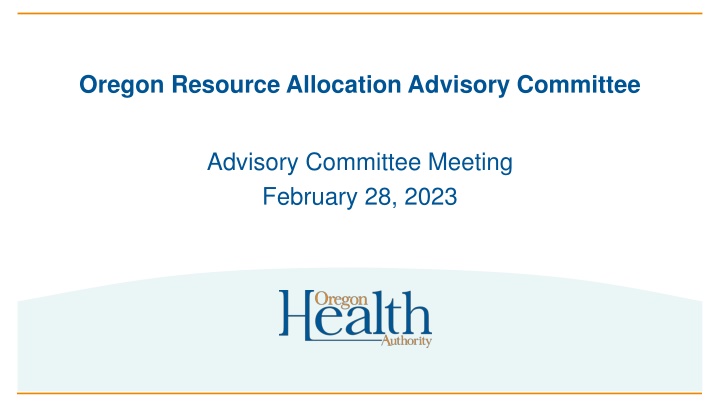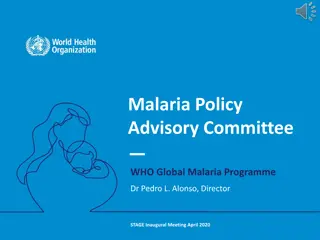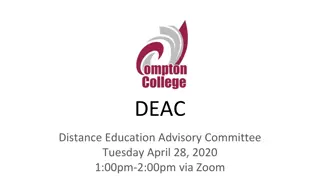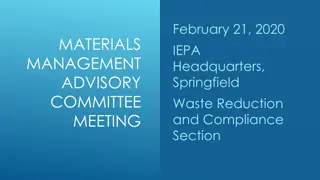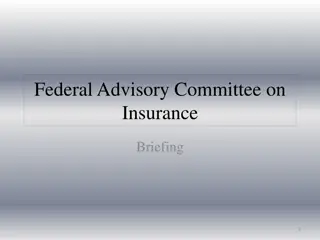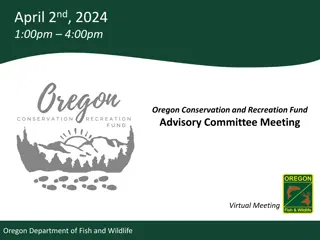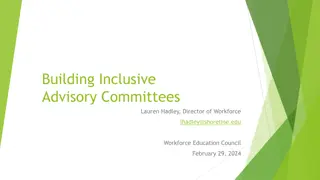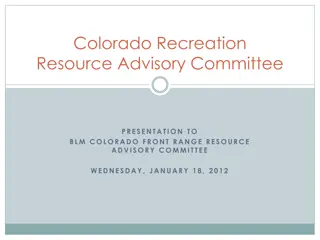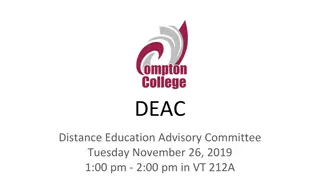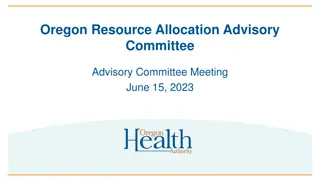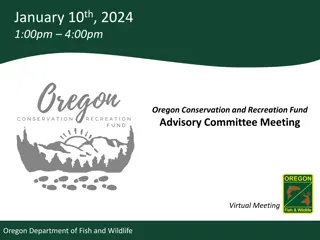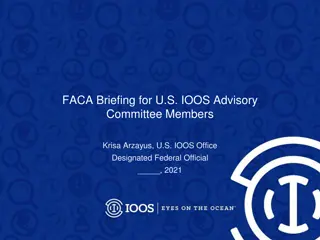Oregon Resource Allocation Advisory Committee Meeting Overview
The Oregon Resource Allocation Advisory Committee meeting on February 28, 2023, will focus on sharing updates on the Triage Approaches and Triage Team & Data Collection subcommittees. The meeting is open to the public and will address important working agreements to ensure a respectful and inclusive discussion. Various resources such as simultaneous Spanish language interpretation and technology support will be available. The agenda includes presentations, discussions, and a summary of the working agreements to guide the committee's collaborative efforts.
Download Presentation

Please find below an Image/Link to download the presentation.
The content on the website is provided AS IS for your information and personal use only. It may not be sold, licensed, or shared on other websites without obtaining consent from the author.If you encounter any issues during the download, it is possible that the publisher has removed the file from their server.
You are allowed to download the files provided on this website for personal or commercial use, subject to the condition that they are used lawfully. All files are the property of their respective owners.
The content on the website is provided AS IS for your information and personal use only. It may not be sold, licensed, or shared on other websites without obtaining consent from the author.
E N D
Presentation Transcript
Oregon Resource Allocation Advisory Committee Advisory Committee Meeting February 28, 2023
Interpretation Click the globe to enable interpretation options. Select the language. You can choose to hear the original audio at a lower volume or select mute original audio to stop hearing the original audio.
Meeting Resources If you need support, we have: Simultaneous Spanish language interpretation Technology support Note taker If you have a need, contact Lisa Bui at: 503-576-9321 Please note that this meeting will be open to the PUBLIC 1. The general public may be in attendance 2. The meeting summary will be posted to OHA s website 3
Purpose Share updates on the Triage Approaches and Triage Team & Data Collection subcommittees 4
Agenda 1. Welcome 2. Triage Approaches subcommittee presentation 3. Break 4. Triage Approaches group discussion 5. Triage Team & Data Collection overview 6. Closing and next steps Total 120 minutes (2 hours) 5
Working Agreements 1. Keep the patients and communities who have been marginalized by mainstream institutions, like the healthcare system, at the center of the discussion 2. Be mindful of paternalism in discussions about elders, people with disabilities, and BIPOC communities 3. Acknowledge the importance of all the services, supports, systems, and perspectives that are present in this committee 4. Be cognizant of how you speak and what you say so we can all understand one another 5. Recognize that participation and engagement looks different for everyone 6. Keep an open mind and come with a willingness to learn and to share 7. Move in the spirit of trust and love 8. Be clear in your communication 6
ORAAC Triage Approaches Subcommittee Process Overview February 28, 2023
Building the Foundation Shared language Relationship Learning together 9
Framing the Discussion Preparing through reading Concerns about SOFA Using disadvantage indices in triage tools Opening the conversation Questions and priorities Expert support 10
Reading Materials Discussed 1. Oregon Interim Crisis Care Tool 2. University of Pittsburgh guidance on the allocation of scarce critical care resources 3. Rationing, racism and justice: advancing the debate around colourblind COVID-19 ventilator allocation. Schmidt H, Roberts DE, Eneanya ND. J Med Ethics 2022; 48: 126-130. 4. The potential impact of triage protocols on racial disparities in clinical outcomes among COVID-positive patients in a large academic healthcare system. Roy S, et al. PLOS One 2021. 5. Racial disparities in the SOFA score among patients hospitalized with COVID-19. Tolchin B, et al. PLOS One 2021. 11
Intent Inflection point Determine the intent of triage Will we worsen, maintain, or reduce health inequities through this approach? 12
Values and Principles Shared understanding: Commonly used approaches do not align with our intent Agreement on values and principles 13
Whats Next Statements Operationalize them Turn into recommendations 15
Process Ahead Present Committee feedback Community engagement recommendations Revised Final Public comment recommendations recommendations 16
Draft Statements Disclaimer Disclaimer: The draft statements to follow in this slide deck were intended for the purpose of generating subcommittee discussion and making progress towards recommendation development. These statements are not intended to represent the positions of the Triage Approaches Subcommittee, consultants or Oregon Health Authority staff. 17
Draft statements (1 of 9) We will center hope and innovation in our work and not be limited but current practices or known options. 18
Draft statements (2 of 9) We will work to achieve procedural justice through transparency, seeking community input on emerging recommendations, assessing local cultural values regarding resource allocation, considering this information as part of recommendation development and addressing concerns that arise. We will prioritize input from communities who face the greatest health inequities. 19
Draft statements (3 of 9) The updated crisis care guidance must also acknowledge: That there is no perfect, universally accepted or accurate approach; justification will be needed for the choices made It will be necessary to continuously evaluate chosen approaches, review data, learn and refine guidance Health systems must develop ongoing partnerships with communities most impacted by oppression and health inequities to develop and refine crisis care guidelines and other approaches to reducing health inequities 20
Draft statements (3 of 9), continued The updated crisis care guidance must also acknowledge: Crisis care tools are but one part of broader efforts needed in a public health emergency necessary to reduce inequities, including but not limited to: emergency preparedness; broad access to culturally responsive healthcare and basic needs; access to needed supports that allow individuals with disability to achieve desired independence and communicate their needs and goals; a diverse, responsive and supported healthcare workforce; local, regional, statewide and interstate communication and movement of patients to access needed care ( e.g., load balancing ) 21
Draft statements (4 of 9) The resource allocation methodology in crisis care guidelines is not adequate alone to reach our goal. Guidance must also outline the composition of the triage team that has decision-making responsibility . The expertise, diversity, role, training and support structures for the triage team are critical to attain the goal to reduce health inequities through resource allocation. 22
Draft statements (5 of 9) We will prioritize health justice allocation factor(s) to achieve our goal. Further exploration needed. 23
Draft statements (6 of 9) We do not recommend using the Sequential Oregon Failure Assessment (SOFA) tool in resource allocation. The tool was developed to assess survivability for one condition (sepsis) and may not apply more broadly. Research shows this tool will exacerbate inequities which is unacceptable. 24
Draft statements (7 of 9) We recommend against use of survivability as a primary factor in resource allocation. This approach is based on a utilitarian model which does not align with cross-cultural priorities. In addition, existing tools to assess survivability are known to or have the risk of exacerbating health inequities. 25
Draft statements (8 of 9) Our task is to set out rules that guide who receives scarce, life-saving resources when there is not enough for everyone who needs them. In our approach to resource allocation, our goal is to reduce oppression, health inequities, and the disadvantage caused by these. 26
Draft statements (9 of 9) We might consider likelihood of imminent death based on clinician prognostication as a factor in resource allocation. (mixed support from subcommittee for this statement) 27
Next steps: We will explore: Use of disadvantage indices as potential prioritization factors that address the intersectionality of disadvantage, including the possible following uses: As a primary allocation factor or tie breaker As a weighted lottery Other potential approaches to reduce health inequities 28
Process Ahead Present Committee feedback Community engagement recommendations Revised Final Public comment recommendations recommendations 29
Triage Team and Data We will not have a separate subcommittee focusing on these topics; we will incorporate the discussion into the full ORAAC committee meetings. Key topics for potential recommendation development include: Role, composition, responsibility of the triage team What data should be collected if resource allocation of life- saving care (e.g., critical care) is utilized 31
Oregon Interim Crisis Care Tool Existing language: CSC triage team (1 of 4) A CSC triage team should be designated by the hospital for implementing critical care resource allocation determinations. Those serving as representatives of the triage team should not be caring for the patient being triaged, unless that is impossible given the staffing capabilities of the hospital. Triage staff must recuse themselves from triage determinations for patients they are personally treating unless no other option exists. 32
CSC triage team (2 of 4) When possible, it is recommended that a hospital s CSC triage team consist of: Two to three senior clinicians with experience in triage (e.g., critical care, emergency medicine, trauma surgery, etc.). This should include at least one physician and one nurse. These clinicians should be licensed and actively participating in their field. A medical ethicist with experience and training as a healthcare ethics consultant. An expert in diversity, equity and inclusion. An administrative assistant to record all triage team decisions and maintain necessary records and documents.
CSC triage team (3 of 4) In order to best mitigate implicit bias, to the greatest extent possible each hospital should have a group of triage officers and a triage team that adequately reflects the diversity of the patient population served by the hospital in terms of demographics such as race, ethnicity, disability, preferred language, sexual orientation and gender identity. Every attempt should be made to assemble a team that reflects the diversity of the community and population served by the hospital. Diversity among triage officers is intended to promote health equity and to mitigate against the perpetuation of health disparities in resource allocation. 34
CSC Triage Team (4 of 4) Members of a hospital s triage team with the responsibility to determine allocation of scarce resources should also have training in implicit bias and anti-racism. If staff with this training are not immediately available, such training for triage team members should be attained as soon as possible. 35
Data Collection and Transparent Communication See OAR 333-505-0036 (Notice and Documentation of Triage Decisions) Hospital Requirements During Emergency Impacting Standard of Care OHA s permanent rule OAR 333-505-0036 was effective January 24, 2023. 36
